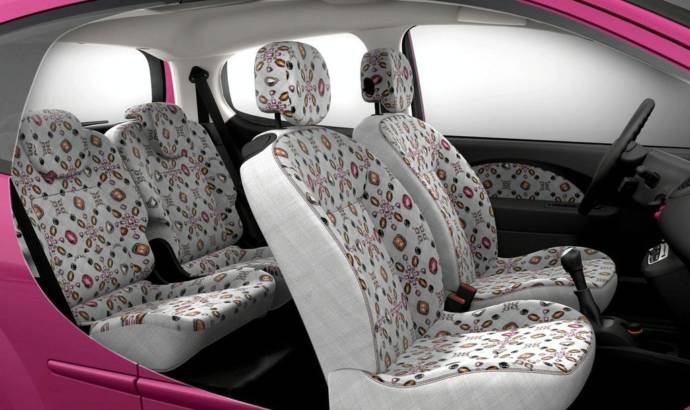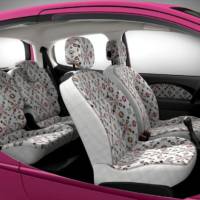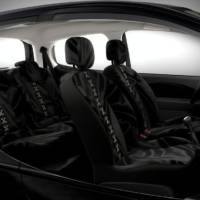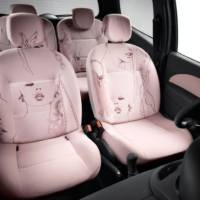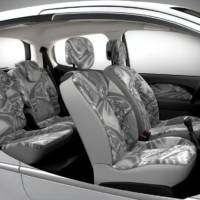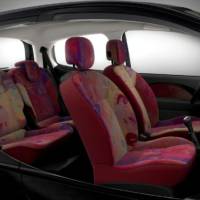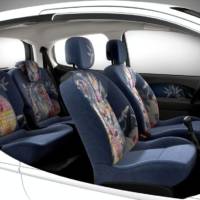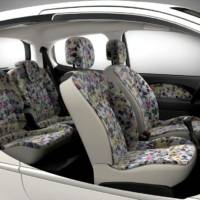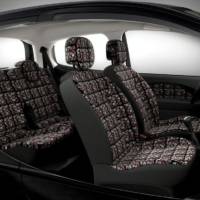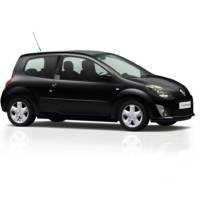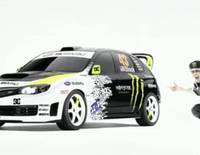Renault introduced a special edition model consisting of 800 units that will go on sale starting June 15 will join their lineup, the Renault Twingo Art Collection. The company says they used technology from the world of fashion in designing the interior for the Renaul Twingo Art Collection, such as the inkjet printing method that applies directly on the upholstery and represents a Europe’s first. This technique offers an unlimited range of possibilities allowing image files with as much as 16 million-colours to be printed onto a white textile.
After four designers expressed their visions using the above mentioned printing method, the work of Swedish designer Christina Drejenstam entitled "Faces" was chosen for the Renault’s Twingo Art Collection interior and it represents "a sensuous expression of the modern woman."
The Renault Twingo Art Collection price starts at 12,050 Euros when equipped with the 1.2-litre petrol engine or at 13,050 Euros if the ultra low emission dCi 65 diesel engine is chosen.
Renault press release :
Technology inspired from the world of fashion features inside the latest take on RENAULT
TWINGO, an exclusive limited edition of 800 cars which goes on sale on June 15. The new ‘Art Collection’ series takes its inspiration from fashion:
– It employs inkjet technology, a technique frequently employed for textile printing in the
fashion world, but a first in Europe regarding the upholstery of a production car,
– Renault asked four designers to submit their personal take on TWINGO, with the lady
motorist in mind,
– Although TWINGO Art Collection only goes on sale on June 15, it will be on show at the
brand’s L’Atelier Renault showroom on the Champs-Elysées in Paris from May 28, and then
on the ELLE.fr website from June 15.
TWINGO Art Collection, exclusive on two accounts:
– Exclusive through its styling:
- Of the projects submitted by the four designers, the creation selected for TWINGO Art Collection was the ‘Faces’ graphic produced by Swedish stylist Christina Drejenstam. This illustration features female faces printed on a specific velour fabric.
- TWINGO Art Collection comes in a striking Pearlescent Black exterior finish.
- The designer’s signature features on TWINGO Art Collection’s B-post.
- TWINGO Art Collection is exclusive, too, in the sense that only 800 cars will be produced. It will only be available for sale in France.
RENAULT TWINGO Art Collection is an affordable limited edition based on the model’s Dynamique equipment level, with a price tag starting at €12,050 (deduction of the French state’s €700 ‘eco-bonus’ included).
After going on display from May 28 until June 11 at L’Atelier Renault (33 avenue des Champs-Elysées, Paris), RENAULT TWINGO Art Collection will star in an innovative staging on the internet accessible via the ELLE website (http://www.elle.fr ) from June 15.
UNPRECEDENTED TECHNOLOGY FOR A EUROPEAN PRODUCTION CAR
Automotive upholstery in Europe tends to employ weft and warp fabrics with a pattern formed by weaving threads of different colours, or occasionally using the technique of roller printing. Until today, high-precision inkjet textile printing has been restricted to haute couture or off-the-peg fashion. Its employment in the world of the automobile has essentially been limited to show cars. Indeed, Renault used the technique for its Modus show car which was unveiled at the 2004 Geneva Show featuring an upholstery pattern based on the theme of photographic reproduction.
Antoine Genin (Colours and Materials Director, Renault Design):
"Inkjet printing opens up an incredible range of creative possibilities by allowing 16 million-colour photographic files to be printed onto a white textile. Used in conjunction with short-pile velour, the photographic finish is not only soft to the touch, but also complies with our commitment to providing our customers with lasting quality."
AN EXCLUSIVE LIMITED EDITION WHICH TAKES ITS INSPIRATION FROM THE WORLD OF LADIESWEAR FASHION
The work selected for TWINGO Art Collection from the projects submitted by the four designers was ‘Faces’ by Swedish stylist Christina Drejenstam.
All four projects will be published on the bespoke Twingo Art Collection website produced in association with ELLE (www.Elle.fr).
‘ Faces’, by Christina Drejenstam:
"For me, this illustration is a sensuous expression of the modern woman. The simplicity of its lines serves to highlight evocative details."
A PARTNERSHIP WITH ELLE AND THE ELLE FOUNDATION
To reach out to fashion conscious lady motorists, Twingo Art Collection is to star on a bespoke website which will focus on the world of design, while at the same time giving potential customers a chance to share their opinions and cast their vote regarding forthcoming collections.
Within the framework of its association with ELLE, Renault invited the winners of the ELLE Foundation’s annual ELLE Solidarité Mode contest to express their vision of the ‘free-minded’ car. A jury made up of representatives from Renault and ELLE then selected three designs which will also feature in the Twingo Art Collection section of the ELLE.fr website. Visitors will be able to vote for their favourite design and perhaps win a TWINGO Art Collection.
DESCRIPTION (FRENCH MARKET)
TWINGO ART COLLECTION: AN EXTENSIVELY-EQUIPPED LIMITED EDITION WITH PRICES STARTING FROM €12,050*
In addition to its soft touch velour upholstery featuring the exclusive ‘Faces’ pattern designed by Christina Drejenstam, Twingo Art Collection is equipped as standard with:
– sliding rear seats,
– an audio system with MP3-compatible CD, remote display, connectivity for an MP3 player
or iPod and fingertip remote control which allows drivers to scroll effortlessly through
playlists,
– an electric panoramic opening sunroof,
– an exclusive Pearlescent Black exterior finish.
Petrol engines:
– 1.2 LEV 16V 75 Renault eco²: €12,750 – CO2 emissions: 120g/km (qualifies for €700 ‘eco-bonus’)
– 1.2 16V 75 Renault eco²: €12,750 – CO2 emissions: 135g/km
Diesel engines:
– dCi 65 Renault eco²: €14,350 – CO2 emissions: 113g/km (qualifies for €700 ‘eco-bonus’)
CREATIVE TALENT
Renault approached four designers, all from different backgrounds, and specializing in different areas of the creative spectrum, with a view to revisiting Twingo.
Christina Drejenstam: Swedish, illustrator, stylist
Christina’s Bachelor of Arts degree is a testimony to her ability to master such classic art forms as drawing, painting and sculpture, Her individual style combines modernism and classicism with a distinctly feminine touch. Her illustrative work is strikingly simple, yet extremely precise in its details. Her talent has already been spotted by brands like Chanel and Nike.
Laurène Stein: French, stylist, fashion designer
Laurène Stein initially studied visual arts before switching to applied arts and then styling studies at the Atelier Chardon Savard. After gaining experience working with young creators in a number of leading houses, she finally set up on her own and established her own brand. Her work is characterized by a very precise take on femininity, which places the emphasis on close cuts and sophisticated yet irresistibly appealing graphic designs. She has developed her own, unique technique, and her portfolio includes such striking items as Bulles bags which are particularly popular in Japan, not to mention her latex bodices which have led to her designing a range of stage costumes for the French rock group Mademoiselle K.
Jeremy Somers, Australian, illustrator
Designer Jeremy Somer has an eye for interesting colour combinations and an approach to objects and people which sits on the border between real world and virtual. He is a big fan of illustrative art, and is irresistibly drawn by the worlds of design and photography. Moritz Rogosky, German, stylist, fashion designer Moritz Rogosky was born in Germany in 1966, but lived in New York until the age of 16. He moved to Paris in 1982 where he enrolled at the Studio Berçot in 1985, graduating in 1987.Moritz Rogosky, German, stylist, fashion designer
Moritz Rogosky, German, stylist, fashion designer
Moritz Rogosky was born in Germany in 1966, but lived in New York until the age of 16. He moved to Paris in 1982 where he enrolled at the Studio Berçot in 1985, graduating in 1987. Very quickly, he chose to specialize in menswear and launched an initial collection for the Japanese market. His multi-cultural background, eventful adolescence in New York, highly creative grandfather – who worked in advertising in the 70s and 80s – and family which produces high-end wine in Tuscany have all influenced his chic yet offbeat collections which make references to the worlds of art and savoir-vivre. His cutting-edge creative style maintains a certain flexibility which seeks to mirror the new generation of young men.
A PARTNERSHIP WITH ELLE AND ITS FOUNDATION
Created in 2004, at the same time as the ELLE Foundation, the ELLE Solidarité Mode (ESM) contest is one of the body’s most emblematic projects and seeks to promote the emancipation of women and girls through education.
Thanks to ESM, the world of fashion is now accessible to young women from less privileged backgrounds. Those who are selected are given a chance to develop their talent and creative skills in one of three celebrated Parisian fashion schools, namely ESMOD, the École de la Chambre Syndicale de la Couture Parisienne and the Studio Berçot.
Each year, in the name of solidarity, the ELLE Solidarité Mode contest brings together an exceptional array of personalities and leading designers who together form the prestigious jury which selects the 10 finalists. The likes of Jean-Charles de Castelbajac, Nathalie Rykiel, Agnès B., Kenzo Takada, Christian Lacroix, Vanessa Bruno, Isabel Marant and Véronique Nichanian have all been involved from the outset, but have since been joined by Jean-Paul Gaultier, Jérôme Dreyfuss, Barbara Bui, Véronique Leroy, Ivana Omazic, Riccardo Tisci, Elie Saab, Vanessa Seward and Olivier Saillard.
Every year, between 250 and 300 young women forward applications.
Following an introduction from Renault Design regarding the thinking behind the project, a number of ELLE Solidarité Mode graduates submitted their personal take on Renault Twingo. A jury made up of representatives from Renault and Elle selected three of these works:
Delphine Katterbach was 21 when she took part in the ELLE Foundation contest in 2007. She is currently in her second year at ESMOD and next year hopes to graduate to the menswear course. For Renault, Delphine came up with an urban-themed illustration with a distinctly Arty Pop flavour.
Stéphanie Thépaut is in her final year at the École de la Chambre Syndicale de la Couture Parisienne. She has already completed an internship of several months at Stella Forest. Stéphanie’s pattern features floral art, with a Grande Fleur motif based on multi-coloured plumes.
Marie-Laure Solinas: During the selection process in June 2008, it was Marie-Laure’s personality which won over the jury. She exudes self-confidence and has a thorough understanding of the fashion world. Marie-Laure only wears second-hand cloths which she recovers from specialist outlets or recovers from the things people throw away. For her Renault project, Marie-Laure chose a modern, creative approach based on the traditional technique of crochet which stands out as a modern form of customization.

